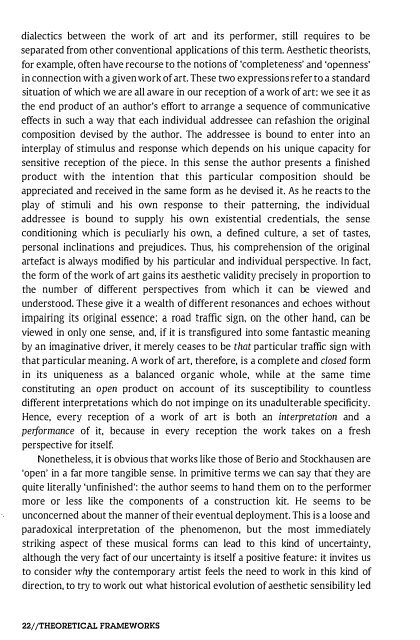Create successful ePaper yourself
Turn your PDF publications into a flip-book with our unique Google optimized e-Paper software.
dialectics between the work of art and its performer, still requires to be<br />
separated from other conventional applications of this term. Aesthetic theorists,<br />
for example, often have recourse to the notions of 'completeness' and 'openness'<br />
in connection with a given work of art. These two expressions refer to a standard<br />
situation of which we are all aware in our reception of a work of art: we see it as<br />
the end product of an author's effort to arrange a sequence of communicative<br />
effects in such a way that each individual addressee can refashion the original<br />
composition devised by the author. The addressee is bound to enter into an<br />
interplay of stimulus and response which depends on his unique capacity for<br />
sensitive reception of the piece. In this sense the author presents a finished<br />
product with the intention that this particular composition should be<br />
appreciated and received in the same form as he devised it. As he reacts to the<br />
play of stimuli and his own response to their patterning, the individual<br />
addressee is bound to supply his own existential credentials, the sense<br />
conditioning which is peculiarly his own, a defined culture, a set of tastes,<br />
personal inclinations and prejudices, Thus, his comprehension of the original<br />
artefact is always modified by his particular and individual perspective. In fact,<br />
the form of the work of art gains its aesthetic validity precisely in proportion to<br />
the number of different perspectives from which it can be viewed and<br />
understood. These give it a wealth of different resonances and echoes without<br />
impairing its original essence; a road traffic sign, on the other hanel, can be<br />
viewed in only one sense, and, if it is transfigured into some fantastic meaning<br />
by an imaginative driver, it merely ceases to be that particular traffic sign with<br />
that particular meaning. A work of art, therefore, is a complete and closed form<br />
in its uniqueness as a balanced organic whole, while at the same time<br />
constituting an open product on account of its susceptibility to countless<br />
different interpretations which do not impinge on its unadulterable specificity.<br />
Hence, every reception of a work of art is both an interpretation and a<br />
performance of it, because in every reception the work takes on a fresh<br />
perspective for itself.<br />
Nonetheless, it is obvious that works like those of Berio and Stockhausen are<br />
'open' in a far more tangible sense. In primitive terms we can say that they are<br />
quite literally 'unfinished': the author seems to hand them on to the performer<br />
more or less like the components of a construction kit. He seems to be<br />
unconcerned about the manner of their eventual deployment. This is a loose and<br />
paradoxical interpretation of the phenomenon, but the most immediately<br />
striking aspect of these musical forms can lead to this kind of uncertainty,<br />
although the very fact of our uncertainty is itself a positive feature: it invites us<br />
to consider why the contemporary artist feels the need to work in this kind of<br />
direction, to try to work out what historical evolution of aesthetic sensibility led<br />
22jjTHEORETICAL FRAMEWORKS








